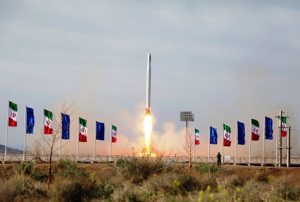On Wednesday, Iran successfully launched a military satellite into space. Though it enhances Iran’s space and rocketry capabilities, it is also likely to increase competition between Iran and its neighbors, as well as between Iran and the United States. Coming on top of existing tensions in the region, it is likely that this launch will only further increase anxieties in the region.
Although Iran has been one of the worst-hit countries by the coronavirus pandemic, Tehran’s behavior in the region has increased tensions in the Middle East. A number of military activities undertaken by Iran in recent days suggest that Tehran is relentless in upping the ante and creating strategic frictions with the U.S. as well as others in the region. These developments come against the backdrop of growing tensions between Iran and the United States after Washington walked out of the 2015 nuclear agreement between Iran and the P5+1. As tensions with the U.S. increase, Iran has been growing closer to China and Russia.
Just this past week, the U.S. criticized Iran for its “provocative maneuvers” in the Persian Gulf. A press release from U.S. Naval Forces Central Command said 11 small vessels of Iran’s Revolutionary Guard Corps Navy engaged in “dangerous and harassing approaches” on American ships including the USS Lewis B. Puller (ESB 3), USS Paul Hamilton (DDG 60), USS Firebolt (PC 10), USS Sirocco (PC 6), USCGC Wrangell (WPB 1332) and USCGC Maui (WPB 1304) during their joint integration exercises with U.S. Army AH-64E Apache attack helicopters in the north Arabian Gulf. It should be noted that the U.S. forces claim that they were conducting their military exercise in international waters.
The statement added that the Iranian vessels “repeatedly crossed the bows and sterns of the US vessels at extremely close range and high speeds, including multiple crossings of the Puller with a 50 yard closest point of approach (CPA) and within 10 yards of Maui’s bow.”
U.S. Naval Forces Central Command also said that this is not in line with the internationally acclaimed Convention on the International Regulations for Preventing Collisions at Sea (COLREGS) or other international customary practices that obligate states to act with due regard for the safety of other vessels operating in the area.
Earlier in March, Gen. Kenneth F. McKenzie, Jr., the commander of U.S. Central Command, stated that “tensions with Tehran have not come down and may be exacerbated” due to the large number of infections and casualty in Iran from the coronavirus. This could very well be the case but U.S. President Trump has responded to Iran’s aggressive moves by saying that “I have instructed the United States Navy to shoot down and destroy any and all Iranian gunboats if they harass our ships at sea.”
All of this makes the situation quite precarious in the Persian Gulf. These kinds of naval incidents could turn quickly into major mishaps. Iran’s behavior also calls into question its adherence to internationally recognized rules of the road in the naval domain.
It was in the middle of these tensions that the IRGC announced that Iran launched its first military satellite, the Nour 1, into orbit at an altitude of 425 kilometers (264 miles). Iran has had a number of failures prior to this week’s successful launch. Most recently in February, its launch of the Zafar 1, a communications satellite, failed. Similarly, in 2019, Iran saw two launch failures, a launchpad rocket explosion and a separate fire incident at the Imam Khomeini Space Center, which killed three researchers. Thus, the success of this week’s launch is a big moment for Iran’s scientific community and the political and military leadership.
The launch was timed well – the fact that Iran has been able to undertake a successful launch of a military satellite on the 41st anniversary of the establishment of the IRGC is politically and militarily an important milestone for the country and, of course, Tehran is using the opportunity to send a strategic message to other powers in the region and beyond. IRGC Commander Major General Hossein Salami congratulated the Leader of the Islamic Revolution Ayatollah Ali Khamenei, the commander-in-chief of the armed forces, and lauded the “new dimensions of the defence power of the Islamic Republic of Iran,” citing it as a “strategic achievement” for Tehran.
Given the growing reliance on outer space by a large number of developed and developing countries, Tehran’s launch is no surprise. In fact, Brigadier General Amir Ali Hajizadeh, the commander of the IRGC Aerospace Force, stated that “access to the space is not a choice but an inevitable necessity and we should find our place in the space.”
Boasting about the rocket, Brigadier General Hajizadeh said that Iran is now part of the club of superpowers that have rockets combining solid and liquid fuel. He added that the rocket – Qassed – that was used for today’s launch “is different from the previous ones as its propulsion system is a combination of liquid and solid fuel. The propulsion system has the same non-metal and composite body which was unveiled a while ago.”
Iran was also proud of the fact that all components of the satellite and the rocket were indigenously developed by Iranian scientists and consider it a proud achievement, especially since Tehran has been under sanctions.
This week’s satellite launch will prompt both regional and global responses. At the regional level, it could trigger reactions from Israel and major Persian Gulf states such as Saudi Arabia. The UAE has had a focused approach to its space program and is far ahead of other regional players; their plans include a Mars mission in 2020. But Iran’s military satellite launch could open some exciting tie-ups and collaborations in the region that may not have been foreseen otherwise. But in the immediate term, it is likely to do little to reduce tensions in the region.

































